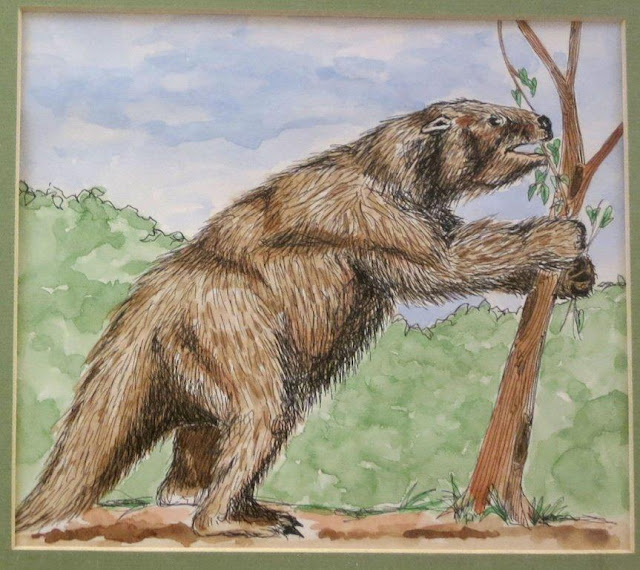Behind my house grows a gigantic wild Honeylocust tree that
is at least 60 feet tall.
its unattractive, leathery pods that drop in great
quantities into my garden in the fall,
and the giant thorns that line the trunk and branches
and are strong enough to pierce a shoe.
In spite of these and a few other undesirable
characteristics I can’t help but respect this giant and wonder why on earth it
has all those thorns.
After all, it takes a lot of energy to produce huge thorns
like these, and an expenditure of energy that doesn’t produce food or
facilitate reproduction had better be worth it to the plant. The obvious answer
to this structure-function question is that the thorns are protection from
animals that might want to eat the bark and twigs of the tree. But digging a little deeper reveals an interesting story and a possible
additional explanation.
The only large browsing herbivore in this part of the world
is the White-tailed Deer. Its relatively small mouth, which could easily reach
between the thorns, leads one to believe that the Honeylocust’s huge thorns are
overkill, and not a sensible expenditure of the plant’s energy. Turn the clock
back more than 13,000 years ago to the late Pleistocene, however, and things
look mighty different. Huge mammals roamed the prairies, forests and savannas,
becoming extinct around the same time as humans colonized North America and the
last ice sheets retreated.
These animals included woolly mammoths, mastodons, horses,
camels, sloths and many others, including large cats and other carnivores that fed on the herbivores. Recently I visited the geology museum at Orton Hall
on the Ohio State University campus to check out the giant ground sloth
skeleton there:
That is one big plant eater! Here is a rendering from the museum that shows the animal
having no trouble reaching way up into trees to find leaves and fruit:
So it certainly makes sense that the thorns of the Honeylocust
protected the tree from these huge mammals. The fact that the Honeylocust’s
thorns only extend about 20 feet up the trunk is probably no coincidence, since
that was about the extent of these animals’ reach.
Lately, though, I’ve been thinking that maybe the large,
tough thorns might also function to attract
giant mammals rather than simply to repel them. How? Picture a louse-y, flea-ridden woolly mammoth sidling up
to a big Honeylocust, gently rubbing its huge flank against the thorns.
Ahhh..relief!
And how does this benefit the tree? Regardless of whether the thorns attract and/or repel the large mammals, the mammoth, or mastodon, or giant ground sloth has no trouble chewing up the plant’s leathery pods. According to Wikipedia, the unripe pods are “strongly crisp, sweet and succulent” (hence the name Honeylocust,and no, I’ve never tried to eat one). Any seeds that pass intact through the animal’s intestinal tract are deposited away from the parent tree, ready to produce another thorny scratching post and food source. Pleistocene seed dispersal at its best!
And how does this benefit the tree? Regardless of whether the thorns attract and/or repel the large mammals, the mammoth, or mastodon, or giant ground sloth has no trouble chewing up the plant’s leathery pods. According to Wikipedia, the unripe pods are “strongly crisp, sweet and succulent” (hence the name Honeylocust,and no, I’ve never tried to eat one). Any seeds that pass intact through the animal’s intestinal tract are deposited away from the parent tree, ready to produce another thorny scratching post and food source. Pleistocene seed dispersal at its best!
In future posts I’ll discuss some of the other Ohio trees that depended on the Pleistocene megafauna for seed dispersal such as the Osage Orange, Persimmon, Pawpaw and Kentucky Coffee Tree. In the meantime, imagine how different life would be if these huge animals still roamed our plains, forests, and backyards!
For more information about this topic, check these articles:
For more information about this topic, check these articles:






Nice article! In Africa elephants push Acacia trees over to eat their tops. In North America I've wondered if Mastodons and/or Wooly Mammoth were doing the same thing and that's why the Honey Locust developed thorns on its trunk.
ReplyDeleteI've never been to the museum at Orton Hall, but now that I've seen the photo of the giant ground sloth I'm intrigued.
And I'll close out with a link to someone's cute photo of a deer eating a honey locust pod. I stumbled across it a while back, and I really enjoyed it: http://www.flickr.com/photos/christianhunold/5124750932/
Deb